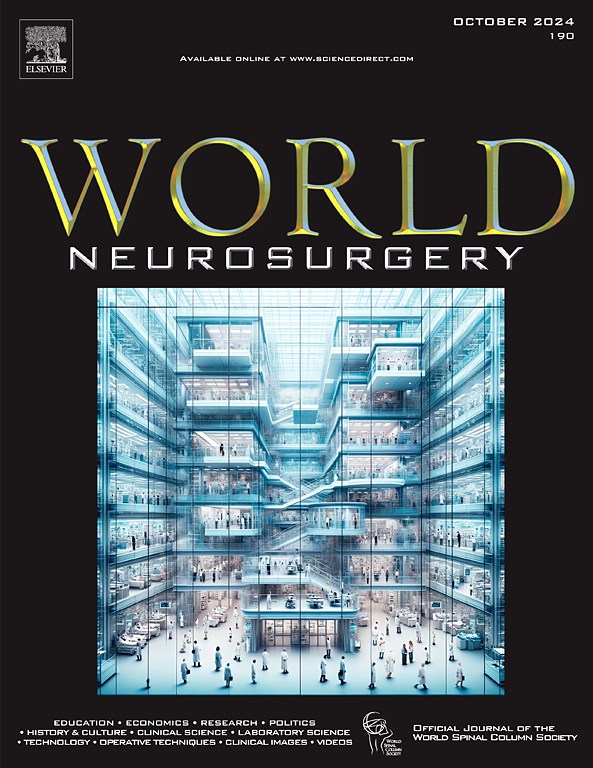急性缺血性卒中患者血管内取栓的危险因素及新的转移途径。
IF 2.1
4区 医学
Q3 CLINICAL NEUROLOGY
引用次数: 0
摘要
目的:血管内血栓切除术(EVT)是治疗大血管闭塞引起的急性缺血性脑卒中(AIS)的一种时间紧迫的治疗方法。为了提高传输效率,我们在台湾中风网络中实施了基于web的EVT传输系统。本研究评估了其对工作流程指标和患者预后的影响。方法:本回顾性队列研究纳入了2021年1月至2024年5月间转移至EVT的AIS患者。将患者分为传统转移途径组(TTP)和新转移途径组(NTP)。考虑到NTP组患者年龄较大,从发病到就诊时间(ODT)较长,样本量较小,使用年龄和ODT进行倾向评分匹配(1:1,卡尺= 0.1)。结果:356例患者(TTP: n = 293; NTP: n = 63),共分析了63对配对。NTP组门静脉到ct血管造影时间(12.2±10.7分钟比39.8±33.8分钟,p < 0.0001)和门静脉到腹股沟穿刺时间(83.0±24.4分钟比109.2±44.6分钟,p < 0.0001)明显缩短。这些改善与更好的结果相关,包括较高的1个月EQ-5D-5L视觉模拟量表评分(61.6±31.9比32.0±30.9,p = 0.004),较低的住院死亡率(11.1%比31.7%,p = 0.009),较低的3个月修正兰金量表评分(3.8±1.7比4.6±1.4,p = 0.004)。高血压和国立卫生研究院卒中量表评分在24-36小时独立预测不良的功能预后。结论:基于网络的EVT转诊系统改善了工作流程和功能结果,即使在小型转诊队列中也突出了其价值。本文章由计算机程序翻译,如有差异,请以英文原文为准。
Impact of Risk Factors and a New Transfer Pathway on Endovascular Thrombectomy Outcomes in Acute Ischemic Stroke
Objective
Endovascular thrombectomy (EVT) is a time-critical therapy for acute ischemic stroke caused by large-vessel occlusion. To improve transfer efficiency, a web-based EVT transfer system was implemented in the Taiwan Stroke Network. This study evaluated its impact on workflow metrics and patient outcomes.
Methods
This retrospective cohort study included AIS patients transferred for EVT between January 2021 and May 2024. Patients were categorized into traditional transfer pathway (TTP) or new transfer pathway (NTP) groups. Given the older age, longer onset-to-door time (ODT), and smaller sample size in the NTP group, propensity score matching (1:1, caliper = 0.1) was conducted using age and ODT.
Results
Among 356 patients (TTP: n = 293; NTP: n = 63), 63 matched pairs were analyzed. The NTP group had significantly shorter door-to-computed tomography angiography (12.2 ± 10.7 vs. 39.8 ± 33.8 minutes; P < 0.0001) and door-to-groin puncture times (83.0 ± 24.4 vs. 109.2 ± 44.6 minutes; P < 0.0001). These improvements were associated with better outcomes, including higher 1-month EQ-5D-5L visual analogue scale scores (61.6 ± 31.9 vs. 32.0 ± 30.9; P = 0.004), lower in-hospital mortality (11.1% vs. 31.7%; P = 0.009), and lower 3-month modified Rankin Scale scores (3.8 ± 1.7 vs. 4.6 ± 1.4; P = 0.004). Hypertension and National Institutes of Health Stroke Scale scores at 24–36 hours independently predicted poor functional outcomes.
Conclusions
The web-based EVT transfer system improved workflow and functional outcomes, highlighting its value even in a small referral cohort.
求助全文
通过发布文献求助,成功后即可免费获取论文全文。
去求助
来源期刊

World neurosurgery
CLINICAL NEUROLOGY-SURGERY
CiteScore
3.90
自引率
15.00%
发文量
1765
审稿时长
47 days
期刊介绍:
World Neurosurgery has an open access mirror journal World Neurosurgery: X, sharing the same aims and scope, editorial team, submission system and rigorous peer review.
The journal''s mission is to:
-To provide a first-class international forum and a 2-way conduit for dialogue that is relevant to neurosurgeons and providers who care for neurosurgery patients. The categories of the exchanged information include clinical and basic science, as well as global information that provide social, political, educational, economic, cultural or societal insights and knowledge that are of significance and relevance to worldwide neurosurgery patient care.
-To act as a primary intellectual catalyst for the stimulation of creativity, the creation of new knowledge, and the enhancement of quality neurosurgical care worldwide.
-To provide a forum for communication that enriches the lives of all neurosurgeons and their colleagues; and, in so doing, enriches the lives of their patients.
Topics to be addressed in World Neurosurgery include: EDUCATION, ECONOMICS, RESEARCH, POLITICS, HISTORY, CULTURE, CLINICAL SCIENCE, LABORATORY SCIENCE, TECHNOLOGY, OPERATIVE TECHNIQUES, CLINICAL IMAGES, VIDEOS
 求助内容:
求助内容: 应助结果提醒方式:
应助结果提醒方式:


